Whether you’re a final year student sitting down to your dissertation or a first year planning upcoming assignments, managing and balancing a busy workload can feel daunting. Here at QMU’s Effective Learning Service we have five steps towards handling and achieving a demanding workload! We invite you to join us as we explore five strategic approaches tailored to your academic journey.
1. Being mindful of your own ‘rhythms’ and patterns
It can be well worth pausing to think about when in the day you are best able to focus on studying. Some time slots might be ruled out for you by activities you are committed to (e.g. going to classes or caring responsibilities) and you need to note these too. But, looking at the times of the day that are available to you, when do you best focus for a study session? A useful thing to try out is a ‘time circle’ as you take stock of how you use your time at the moment, and pin down any areas you might like to tweak.
Draw out the circle of a clock face and divide it into sections, with your main daily activities noted in each one. Aim to adapt the size of each section according to how much time you spend on each activity daily (you can do this very roughly or very exactly by adding hours to your clockface). How does it shape up? Is there anything surprising coming through? You might be adding activities like: travel, class time, study time, cooking/eating, socialising, free time, sleep. Which sections of your clock are looking bulky, and which are a little leaner? Are you happy with the division or is there any tweaking to be done with how much time is going in these different directions?

2. Deciding on quick wins versus leafy greens
This can be a handy way of thinking about your tasks as you sit down for a study session. Do you have reliable ‘quick wins’? These are little jobs that won’t take too long or be tricky to complete. It might be something like putting your reference list into alphabetical order, or sending a message to a friend to arrange a study session the following week.
On the other hand, ‘leafy’ greens are the tasks which feel a little tougher to tackle. It might be approaching a long article or chapter, getting started with a piece of writing or returning to a paragraph you feel isn’t quite right yet.
For some, getting started by ticking off a few of those ‘quick wins’ can provide a little boost and momentum for the rest of the study session. At other times it might be that getting through one of those ‘leafy greens’ right from the offset is the best option for you. Take stock as you prepare to study, and consider which of these approaches will get you off to a more solid start and get into a good mindset for your session.
3. Planning with bannisters
Having a really clear ‘big picture’ of your semester is a great thing to have and here you can note your key submission days, main goals for completing drafts or other life events that are on the horizon. However, sometimes things don't go according to plan and that’s ok too.
A good way to think about these plans, isn’t as rigid, unchangeable and always necessary, but instead as support bannisters which you can lean on when you need to, and when it’s helpful to you. When a particular week is shaping up to be busy, or a particular day is one in which more detailed planning would be valuable, lean on these bannisters to help you. When you do choose to make use of a planner, aim to write very concretely what you’re planning to do in each slot. Rather than writing ‘study’, aim to have something more like ‘draft paragraph 3’. Be sure to also build in time for rest and start to consider what ‘blocks’ of time work best for you, e.g. 25 minutes of study then 5 minutes of rest.
4. Planning backwards – colour or shape coding
Planning backwards from a key date can be surprisingly calming, and might help you see that you have more units of time than there initially seemed to be. As you do this, categorising certain tasks or task types with colours or shapes can be really helpful too, and allow you to group and prioritise the things you need to do.

5. Get outside
This is not wasted time! Taking a break away from your usual study space can be a hugely valuable (and often time saving!) thing to do. A change of scenery can help your ideas come together, can help you come to solutions or understandings as you take a little pressure off yourself and can inspire a dose of creativity that might just be the spark you need for your studies at that moment in time. You might even choose to use your phone to record your thoughts, or voice the areas of your work that you’re mulling over to listen back to later. If revising, a handy strategy can be creating a little podcast or quiz for yourself as you run through your notes at your desk, and then listening back to this as you take a walk outside.

For more resources, videos and tips into planning your time (and much more!) visit the ELS page.







